Description
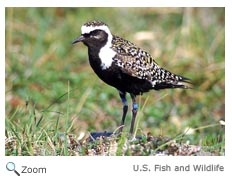 The American golden plover is a medium-sized bird. It is 9-11 inches in length with a wingspan of 22 inches. It has long legs; a short, pointed black bill; and a small, round head. Its wings extend beyond its tail when they are folded. It has a black and golden-yellow speckled back and a grayish-brown breast, neck, and sides. During breeding season, its breast, face, throat, and belly are brownish-black, and it has a white stripe running from its forehead down the back and sides of its neck. Males and females look similar, but the male is more brightly colored. The American golden plover looks similar to the black-bellied plover, but the American golden plover doesn't have a white rump or wing stripe. The American golden plover is a medium-sized bird. It is 9-11 inches in length with a wingspan of 22 inches. It has long legs; a short, pointed black bill; and a small, round head. Its wings extend beyond its tail when they are folded. It has a black and golden-yellow speckled back and a grayish-brown breast, neck, and sides. During breeding season, its breast, face, throat, and belly are brownish-black, and it has a white stripe running from its forehead down the back and sides of its neck. Males and females look similar, but the male is more brightly colored. The American golden plover looks similar to the black-bellied plover, but the American golden plover doesn't have a white rump or wing stripe.
Range
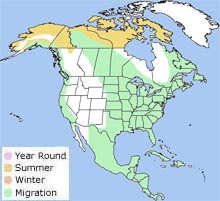 The American golden plover breeds from western Alaska across northern Canada to Baffin Island, south to northern British Columbia, Canada and northern Manitoba and Ontario, Canada. It winters in central and southern South America. The American golden plover is also found in Siberia The American golden plover breeds from western Alaska across northern Canada to Baffin Island, south to northern British Columbia, Canada and northern Manitoba and Ontario, Canada. It winters in central and southern South America. The American golden plover is also found in Siberia |
|
Habitat 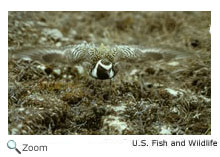 The American golden plover breeds on the Arctic tundra. It winters in grasslands. During migration, it can be found in prairies, fields and pastures, mudflats, shorelines, and beaches. The American golden plover breeds on the Arctic tundra. It winters in grasslands. During migration, it can be found in prairies, fields and pastures, mudflats, shorelines, and beaches.
Diet
The American golden plover eats flying insects, worms, spiders, berries, and seeds. It probes with its bill for food and also chases its prey.
Life Cycle  The male builds a scrape on the ground and lines it with moss, lichen, leaves, and dried grass. The female lays 3-4 eggs, and both the male and the female incubate the eggs for 26-27 days. The chicks are precocial - they walk and feed themselves shortly after birth. Both parents care for the chicks until they fledge at 22 days. Male and female pairs often mate for more than one year. The male builds a scrape on the ground and lines it with moss, lichen, leaves, and dried grass. The female lays 3-4 eggs, and both the male and the female incubate the eggs for 26-27 days. The chicks are precocial - they walk and feed themselves shortly after birth. Both parents care for the chicks until they fledge at 22 days. Male and female pairs often mate for more than one year.
Behavior
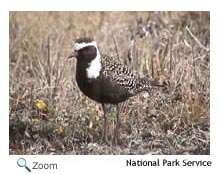 The American golden plover migrates in a circle! In the late summer, the American golden plover migrates up to 2,500 miles from the Arctic to South America, flying over the Atlantic Ocean. In the spring, it returns to the Arctic, but instead of flying back over the Atlantic, it flies over the Great Plains! |
 The American golden plover migrates in a circle! In the late summer, the American golden plover migrates up to 2,500 miles from the Arctic to South America, flying over the Atlantic Ocean. In the spring, it returns to the Arctic, but instead of flying back over the Atlantic, it flies over the Great Plains!
The American golden plover migrates in a circle! In the late summer, the American golden plover migrates up to 2,500 miles from the Arctic to South America, flying over the Atlantic Ocean. In the spring, it returns to the Arctic, but instead of flying back over the Atlantic, it flies over the Great Plains! 
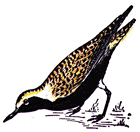

 The American golden plover breeds from western Alaska across northern Canada to Baffin Island, south to northern British Columbia, Canada and northern Manitoba and Ontario, Canada. It winters in central and southern South America. The American golden plover is also found in Siberia
The American golden plover breeds from western Alaska across northern Canada to Baffin Island, south to northern British Columbia, Canada and northern Manitoba and Ontario, Canada. It winters in central and southern South America. The American golden plover is also found in Siberia 
